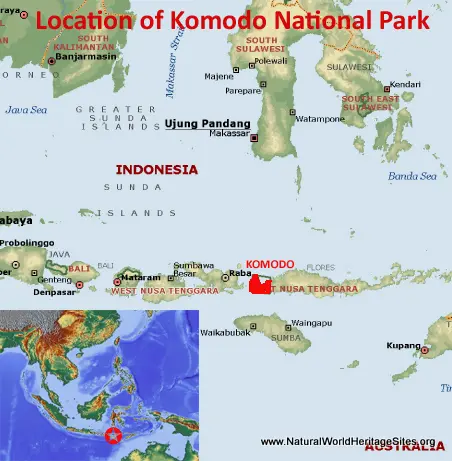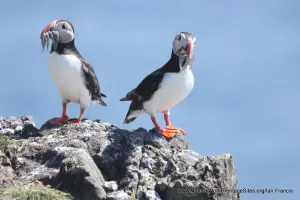EXPLORE Indonesia’s Komodo National Park with this slideshow, check the location map and get all the facts and information below.
For slideshow description see right or scroll down (mobile). Click to view slideshow
Location and Values: Komodo National Park is located in the geographic centre of Indonesia, along the chain of islands that runs between Java in the west and Papua in the east. It includes three major volcanic islands (Komodo, Rinca and Padar), numerous smaller islands and areas of pristine seas with abundant coral between the islands. The park’s most notable inhabitant is the Komodo Dragon (Varanus komodoensis), the world’s largest lizard, which grows to a length of 3m and can weigh up to 100kg. It is an aggressive hunter which preys on large mammals including water buffalo, deer, wild boar and feral goats, and has a formidable reputation. The islands and underwater seascapes are both astonishingly beautiful, so the area has become a popular diving location as well as a dragon-spotting one. The archipelago of islands with their craters, grassy hillsides, rocky headlands, palms, mangroves and forests touch the crystal clear waters along a coastline of stunning coves, beaches and headlands, with extraordinary far reaching views from any vantage point. The seas support some of the richest coral reefs in the world with blue and sperm whales, giant manta rays, ten species of dolphin and no fewer than five species of turtle.
Conservation Status and Threats. According to IUCN’s most recent Conservation Outlook Assessment (December 2020) the conservation status of Komodo National Park is considered to be of ‘significant concern’. The exceptional values which are recognized by the site’s inscription on the World Heritage List are significantly threatened by:
- Climate change. The impacts of climate change are not yet fully understood but may already be responsible for a broad range of changes with warmer waters resulting in an increase in coral bleaching. An increasing frequency and intensity of storm events, combined with sea-level rise, may further damage reef systems. A related risk is the acidification of seawater due to increased absorption of atmospheric carbon dioxide, which may inhibit the formation of calcium carbonate, the basic substance forming the skeleton of corals, and the shells of marine organisms.
- Fire. The expected increase in temperatures and drought conditions due to climate change is likely to result in increased incidence of fire, which may affect the savannah and forest habitats of the Komodo dragon and other terrestrial species, perhaps impacting on their long-term survival.
- Human population increase and expansion of settlements. Komodo National Park and its immediate surroundings support an expanding population of about 20,000 people, many of whom depend on natural resources from within the park. This has resulted in over-fishing, use of destructive fishing practices (with accidental capture of endangered species such as turtles and dolphins), poaching, wildlife trade in endangered species (including komodo dragons), cutting of forests for firewood, and shortage of freshwater supplies. In addition, the expanding settlements are causing pollution from sewage and trash, oil/fuel spills in the marine environment, and runoff from fertilizers and pesticides. The Park’s ecosystems cannot sustain the increasing demands and pressures of this growing human population indefinitely.
- Poorly regulated tourism. Visitor numbers have increased rapidly in recent years and visitor interactions with Komodo Dragons is altering the dragon’s physical condition and behaviour. In addition, poor management of tourist boats, including anchoring on coral reefs, disposal of garbage at sea and fuel oil leakage is having a direct (if limited) impact on the reefs and marine environment.
- Infestation by the coral-killing sponge Chalinula nematifera. This invasive alien species, which preys on many species of hard coral, is reaching plague proportions in some areas and exacerbating the problems facing the marine environment in Komodo National Park.
- Over-fishing. Destructive fishing practices (with cyanide, blast fishing, reef gleaning or ‘meting’) and over-exploitation have been reported previously as major threats to the reef habitats of Komodo National Park. Significant efforts have been made to control these practices but the extent to which they continue is unknown.
Links:
Google Earth
IUCN Conservation Outlook
UNEP-WCMC Site Description
Official UNESCO Site Details
Birdlife IBA
Slideshow description
The slideshow ‘tells the story’ of Indonesia’s Komodo National Park with a portfolio of photos by Peter Howard from a visit in April 2018.
Factfile
Website Category: Islands
Area: 2,193 km2
Inscribed: 1991
Criteria:
- Outstanding natural beauty (vii);
- Significant number of rare, endemic and/or endangered species (x)





